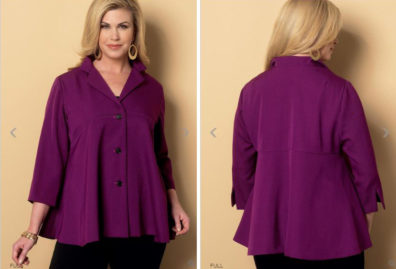
The Dilemma
Awww, the Holidays. ‘Tis the season for your work party, his work party, a girl’s night out or two, holiday concerts, and all the family gatherings . . . . whew! What’s a sewist to wear without making a new outfit for every occasion? Enter the classic Little Black Dress. Simple and economical to make, it can easily be the most versatile go-to in your holiday wardrobe. All it takes is a little more sewing!
The Solution
The Little Black Dress on its own can be fabulous with just the addition of jewelry that sparkles or a drop-dead-gorgeous print sewn into a quick infinity scarf. For your holiday LBD, consider one of the patterns I found on the Simplicity web site. Each one carries its own impressive style, yet is simple enough to sew up in just a few evenings.

From the Amazing Fit collection, Simplicity 8258 is available in petite, misses and plus sizing. Fitting tips and techniques are included for this impressive, yet simple design. The fit and flare styling, center front seaming and three sleeve options make this the perfect LBD for everyone. And, there are pockets!

Designed by Sew Chic’s Laura Nash, vintage inspired Simplicity 8534 features a gorgeous, slimming waterfall drape. Easy pleating at the bust and waistline creates a wonderful fit and marvelous style. To make this your own, options include long or short sleeves, optional self-piping and a charming bow.

Basic, easy, yet striking, New Look 6524 includes four different sleeve looks and lengths. It’s a wonderful dress for “The Year of the Sleeve”! Sew up a holiday style Little Black Dress now, then save this pattern for a fun warm weather dress, too.
The Additions
So, now that you’ve sewn the perfect LBD, just a little more sewing will make it a great fit for all your holiday events! The layering styles I found for you can change for each occasion depending on which fabrics you choose and the unique touches you add.

Think about silk, velvet, rayon, sparkly trims, sequins and fancy machine stitches. For embellishing, consider Dana Marie Design’s exquisite Quick Fan Applique tutorial to add personalized style.

Connie Crawford’s Butterick 6261 is a magnificent flare jacket with beautiful seam detailing. Marvelous for combining prints, it could also stylishly feature a yoke of sparkly, sequined fabric. A wonderful way to complete your outfit for holiday concerts or a dress-to-impress work party!

For a more formal office party or girls’ night out, you’ll love the New Dimension Jacket designed by Louise Cutting. Beautiful princess seaming and full-length dolman sleeves create a slim, flattering fit that would be superb in velvet or a mid-weight silk. Two necklines and optional pockets offer alternatives for design that may mean you’ll want to make more than one!

Karen Nye’s fabulous and ever-popular CNT Patterns A Little Somethin’ Jacket is quick, easy and a great fit for all body styles. You’ll find two sleeve lengths available and a wide size range. Stitch this one up for the family gathering in a gorgeous rayon. For a Holiday Concert or special night out, choose a dazzling lace for spectacular results.
The Joy
Get ready to look fabulous, darling. Choose your fabrics; choose your patterns – holiday dressing offers simply marvelous reasons to indulge in the joy of sew!
About the author: Annette Millard recently started her own blog, The Sewful Life, which utilizes her sewing and teaching experience to provide helpful tips and tricks, tutorials, and project ideas. Visit the blog at sewfullife.com .






